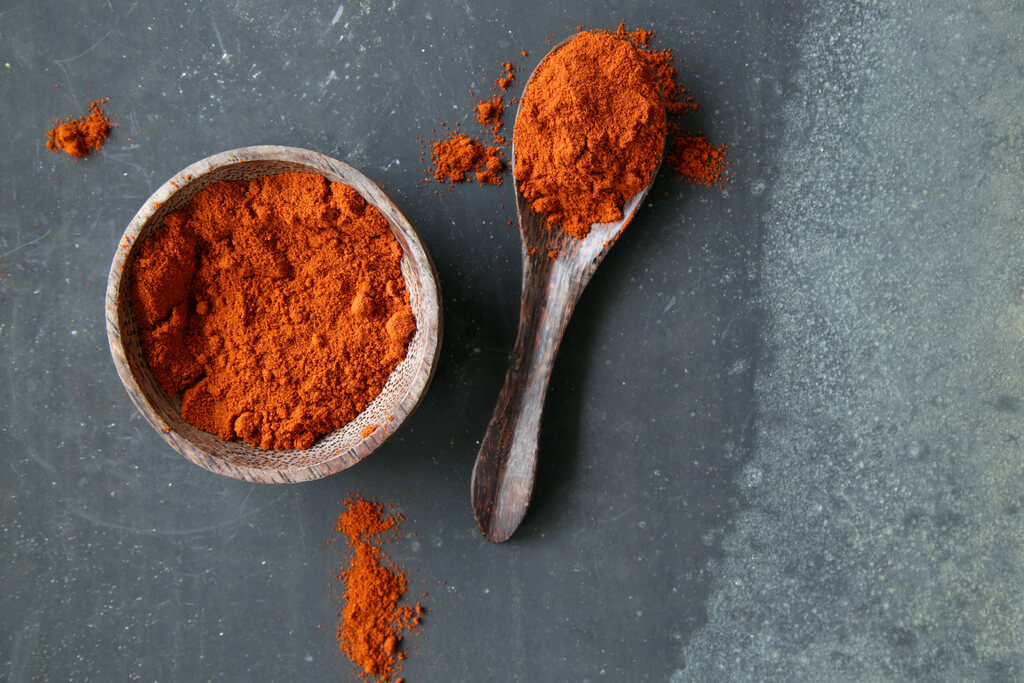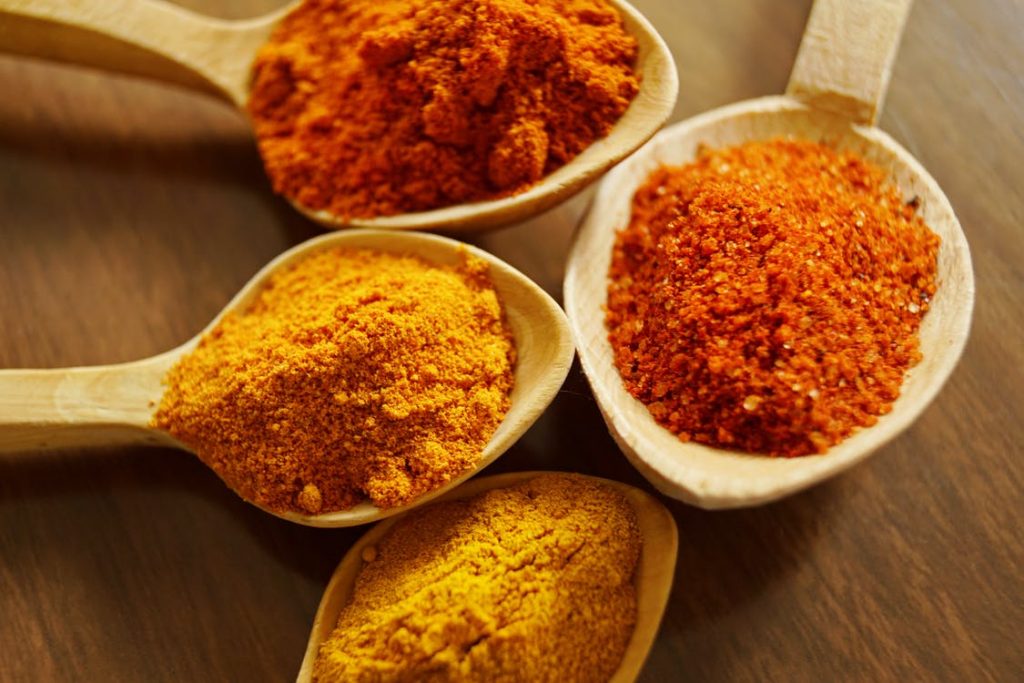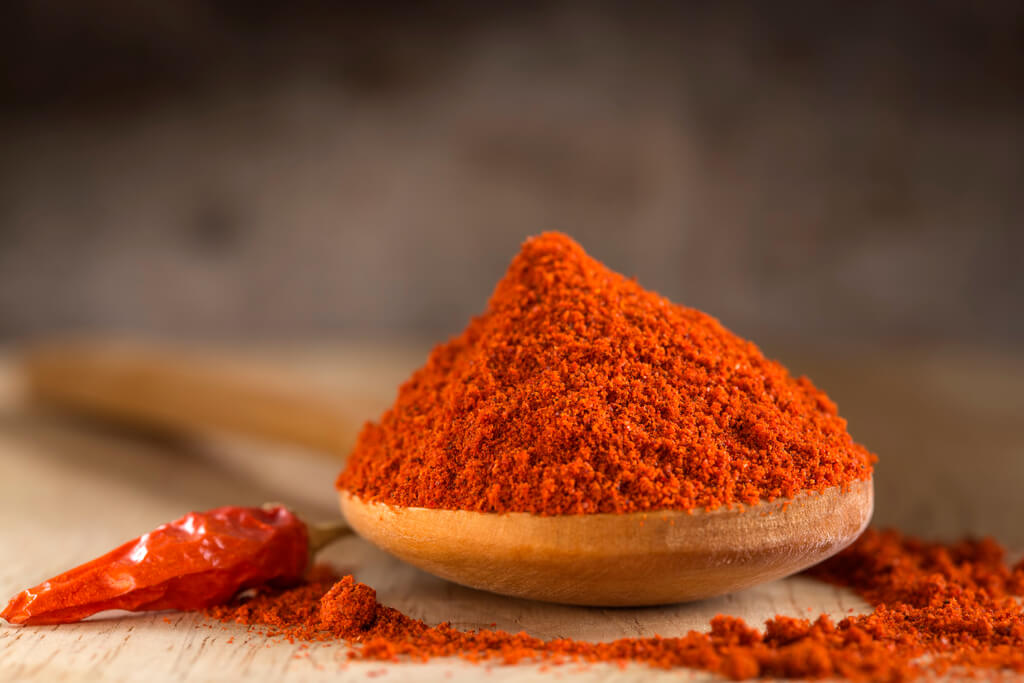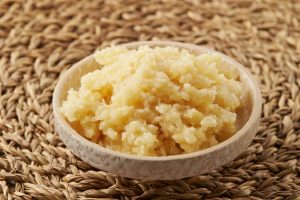
Paprika is a spice blend made from a mixture of sweet ground peppers from the Capsicum annuum family such as bell pepper and hot chili peppers. There are three main types of paprika: smoked, sweet, and hot. Whichever type, this spice has a vibrant deep red color that features a smoky and fiery flavor with slightly sweet notes. It’s best recognized for the nuanced spicy kick it adds to deviled eggs, stuffed bell pepper, and hummus, and is also a well-known chili powder substitute for a wide variety of dishes. Now in case you’ve run out of this essential spice, let’s explore paprika substitute options you can try below.
Read on as we show you what paprika is made of, its different types, and what substitutes work better for each one. You’ll also find out how to make your own paprika at home!
What Can I Substitute for Paprika?

Smoked Paprika Substitutes
This type is made from gradually smoking pimentón (a type of Spanish smoked pepper). Since it’s dried by way of smoking, the flavor it imparts is somewhat woody, peppery, and smoky with a mild spicy kick. Unlike other types, this one is prized for its smokiness rather than the heat level it can provide. Check the best smoked paprika substitute options below:
- Chipotle powder
- Ancho chili powder (also makes for a great sweet paprika substitute)
- Cajun spice
- Cumin + regular paprika + cayenne chili powder
- Crushed red pepper flakes
Chipotle Powder
Chipotle powder is probably the best smoked paprika substitute on your spice rack. Like the original ingredient, this replacement is also considered mildly spicy with a heat level that ranges from 2,500 to 8,000 Scoville Heat Unit (SHU) on the Scoville Scale. Made from smoked dried jalapeño peppers, this spice is also known for its remarkable smoky and earthy taste — the result of the smoking process. Its bright red color also closely resembles paprika. All things considered, the chipotle powder is a fantastic backup for smoky dishes rather than spicy recipes.
Switching with this spice is pretty straightforward. Just use an equal amount of chipotle powder for every smoked paprika the recipe calls for.
Ancho Chili Powder
Another worthy replacement for smoked paprika is ancho chili powder. It’s made from dried and ground ancho chiles. This pepper is more common in Mexican cooking but found its way into the United States by way of Tex Mex cuisine. They offer mild to medium heat that only ranges from 1,000 to 1,500 SHU. It has a deep, smoky and slightly sweet flavor. For this reason, you don’t have to worry as much when using this as a replacement as it won’t overpower your dish as easily compared to chipotle powder. To use as an effective backup, you can incorporate exactly how much a recipe calls for smoked paprika.
Aside from making a great replacement for the smoked type, ancho chili powder also makes for a great sweet paprika substitute because of its sweet flavor that is similar to the taste of raisins.
Cajun Spice
Basically made of paprika, cayenne pepper powder, garlic powder, oregano, and other flavorful seasonings, Cajun spice (also called Cajun seasoning) features a bold spicy flavor with a subtle earthiness. Although it contains the combined heat of paprika and cayenne, this seasoning is considered mild because, again, it’s made with a combination of seasonings. Despite being made from a combination of spices, some versions are still hot because different brands pack different amounts of ground peppers in their bottle. For this reason, we recommend testing this alternative first before using it.
Incorporate this with a 1:1 Cajun spice to smoked paprika ratio (more if your bottle at home is milder or less if it’s spicier).
Regular Paprika + Cayenne Chili Powder + Cumin
Now, what if you have regular paprika but don’t have the smoked variant? Can you still use it? The answer is yes! But only if you combine it with cumin and cayenne. On its own, regular or plain paprika doesn’t have the flavor that its smoked version is known for. Mixing it with cumin will bring a rich and earthy flavor, while cayenne adds heat and smokiness. With all three, you can create something close to smoked paprika.
For this swap, you need to mix a pinch (⅙ teaspoon) of paprika and cumin and a dash (⅛ teaspoon) of cayenne. You can also adjust other ingredients to your taste. To use as a swap, use exactly as the recipe calls for smoked paprika.
Crushed Red Pepper Flakes
Crushed red pepper flakes are basically just dried peppers that are not ground to powdered form. Because it has not been ground further, it will leave you a mix of seeds and pepper flakes. This condiment is often used to garnish pizza, soups, and stews to add a layer of spicy flavor. That said, it might not be a good backup for some recipes because of its coarse texture. The good thing is you can always use your handy spice grinder to ground it into powdered form.
Red pepper flakes are hotter than paprika, so we recommend substituting ⅓ teaspoon of red pepper flakes for every 1 teaspoon of paprika. Add more to taste if you want more heat.
Sweet Paprika or Regular Paprika Substitutes
While the smoked variant is the responsible ingredient for the smoky flavor in many recipes, sweet paprika gives your dishes a fruity, sweet and slightly bitter flavor with very little to no heat at all. If you happen to spot the usual bottle that just says paprika, that’s most likely the regular or sweet variant.
In case you run out, use the following sweet or regular paprika substitution options below:
- Tomato sauce + chili powder
- Chili powder
- Bell peppers
- Gochugaru powder
Tomato Sauce + Chili Powder
Tomato sauce sports a nice bright red color and a sweet taste that mimics that of the sweet paprika. However, these qualities alone without the spice are not enough as a swap. Mixing it with chili powder will add the heat that tomato sauce lacks. There’s a catch, however. Since this backup is wet, it’s only good for recipes like stews and soups.
To use this mixture, combine tomato sauce and chili powder in equal amounts. Then, incorporate in dishes in a 1:1 replacement to sweet or regular paprika.
Chili Powder
If you want to add a nice spicy kick without all the overpowering heat, chili powder is a suitable sweet paprika substitute. Despite that, you can’t use chili powder in a 1:1 substitution because of its noticeable savory flavor that comes from a mix of other spices such as onion powder, cumin, garlic, and more. In general, it has an earthy, savory, and slightly spicy taste. But it will do if you’re in a bind or in the middle of garnishing your deviled eggs and curries.
For this backup, start with a small amount and adjust according to the dish’s preference. You may also adjust other seasonings if needed.
READ ALSO: 12 Chili Powder Substitute Choices To Flavor Your Dishes
Bell Pepper Powder
Compared to other substitutes in this list, bell peppers are generally sweet, mild, and tangy which somewhat fits the description of sweet paprika. When using this as a backup, note that your dish will have an intriguing yet bright flavor profile that better suits pasta, chicken, salads, and soup recipes. To add to its impressive list of qualities, it’s also incredibly aromatic that adds overall allure to the dish.
Now, what if you can’t find bell pepper powder at your local grocery store? It requires short work and it can be daunting at first, but you can make your own powder at home. To start, you have to dehydrate them first and then ground them to powder using a spice grinder or mortar and pestle. To use as a backup, simply double the amount as the recipe suggests.
Gochugaru Powder
Those who love Korean cuisine probably already know this next backup. Gochugaru powder is better known in the US as ground Korean chili powder. This famous Asian condiment is loved for its sweet and spicy taste with a subtle smoky note, making it a nice paprika alternative. It’s also prized for its color which adds a bright red hue to dishes like tteokbokki (Korean spicy rice cake) and yukgaejang (spicy beef soup).
To incorporate in dishes with paprika, use one teaspoon of gochujaru powder for every teaspoon of sweet or mild paprika. Of course, you may add more if you want more heat.
Hot Paprika Substitutes
We finally boiled down to the last type: hot paprika, also called Hungarian paprika. Made with extra spicy red peppers, this variant packs a lot of heat compared to the first two types. That is why a pinch or a dash goes a long way for this spice. Use the following hot paprika substitute choices below:
- Cayenne pepper powder
- Hot sauce
- Guajillo chili powder (also a great substitute for smoked paprika)
- Aleppo chili powder
Cayenne Pepper Powder
Ranging from 30,000 to 50,000 SHU, cayenne is definitely spicier than hot paprika. All the same, this ingredient is one of the best hot paprika substitutes there is because of its striking color and noticeable heat level.
Since it’s hotter than paprika, we recommend incorporating it in small amounts and adjusting other ingredients such as broth, cream, and even adding other seasonings to calm the heat. But while cayenne adds a spicy kick, we’re afraid it won’t add much in terms of flavor. Aside from adjusting other ingredients, you may also combine it with a bit of sugar or honey to add depth and bring a little sweetness that this backup lacks.
READ ALSO: 10 Cayenne Pepper Substitutes (and How to Use Them!)
Hot Sauce
Hot sauce has varying flavors from brand to brand, but overall, it is spicy, smoky, citrusy, a little sweet, and sometimes nutty. If you’re looking for a replacement that mimics paprika’s taste rather than color, hot sauce is your next best pick. This works for soups and stews where you can hide its runny consistency. Add one teaspoon of hot sauce for every one teaspoon of paprika in recipes.
Guajillo Chili Powder
Pronounced as “gwaa-hee-oh“, guajillo is hotter than ancho chili powder and brings a spicy kick that ranges from 2,500 to 5,000 SHU. Apart from its spicy taste, this substitute has a lot more going on in flavor than cayenne. It is pleasingly sharp, tangy, and smoky just like paprika. That is why it’s also a good substitute for both hot and smoked paprika.
But while it’s a good fit in terms of flavor, its appearance might not be a good substitute because of its reddish-brown color. If you don’t mind the slight visual differences, we suggest adding guajillo in slow progression until you reach your desired taste.
Aleppo Chili Powder
A common Middle Eastern spice, Aleppo chili powder is used to season meat, salads, sauces, and dips. Basically, you can use it as you would any type of paprika. Another notable similarity is their heat. Aleppo has moderate to medium heat with a salty and earthy flavor. But since it’s salty, this swap should not be one is to one. We suggest starting with ¼ teaspoon and gradually adding more to taste.
Now, let’s say you don’t have any of these ingredients, your last resort would be to use black and white pepper to replicate the peppery and smoky kick that paprika offer. Chili flakes will also do in some recipes that use paprika as a garnish such as deviled eggs and potato salad.
How to Make Your Own Paprika

If you’re willing to go the extra mile and would rather make your own paprika, then follow the recipe below. After all, homemade food (and spice) is always better!
Equipment:
- Dehydrator
- Spice grinder
Ingredients:
- Paprika peppers
- Bell pepper
Steps:
- Place the paprika and bell peppers in the dehydrator tray. Set it to 130 degrees F or until peppers are fully dried.
- Remove seeds and grind. You may use a mortar and pestle if you don’t have a spice grinder.
- Lastly, store in an airtight jar. For maximum shelf life, avoid storing in direct sunlight and store in a cool, dry place.
Frequently Asked Questions
What is paprika used for?
Paprika is often used as a seasoning to add a spicy kick to sauces, soups, stews, and salads. Besides being a perfect finishing touch for deviled eggs and hummus, it’s also a common ingredient in spice blends and rubs.
Is paprika good for you?
Paprika has a number of health benefits on its belt. It is a great source of antioxidants that help boost the immune system, alleviate gas, and prevent cancer and heart diseases. Avoid consuming too much at a time, however, as it could upset your stomach and cause sweating and a runny nose.










